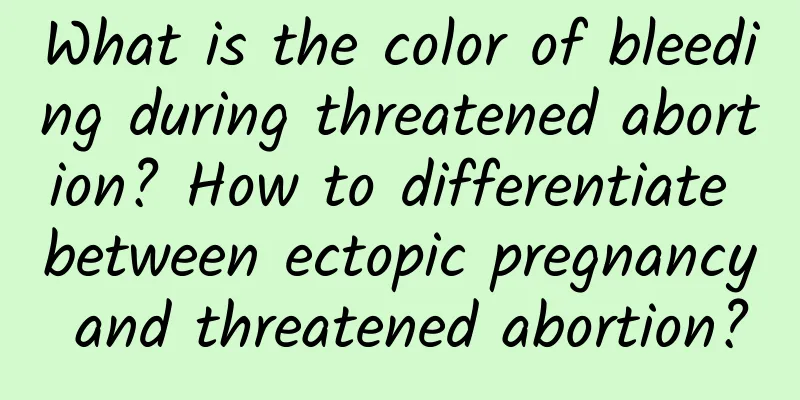What is the color of bleeding during threatened abortion? How to differentiate between ectopic pregnancy and threatened abortion?

|
Threatened abortion generally presents with backache, abdominal pain and abnormal vaginal bleeding as the main symptoms, which eventually lead to the fetus spontaneously leaking out of the body and causing pregnancy failure. However, in clinical practice, there are many abnormal pregnancy conditions that are very similar to the symptoms of threatened abortion, such as ectopic pregnancy and inevitable abortion. Today, we invited Pan Ying, the attending physician of the First Affiliated Hospital of Jinan University, to explain to us the main differences between threatened abortion, ectopic pregnancy and inevitable abortion. What is the color of bleeding during threatened miscarriage? The color of blood flowing out of a pregnant woman with threatened abortion varies from person to person and cannot be generalized. Most pregnant women have bright red blood when they have threatened abortion, while a small number of pregnant women have dark red or even brown blood. The difference in the color of a pregnant woman's blood is related to the time the pregnant woman's blood stays in the reproductive tract and the amount of bleeding. Generally speaking, the blood of a pregnant woman with a small amount of blood and a long time in the reproductive tract is dark red. How to differentiate between ectopic pregnancy and threatened abortion? The bleeding symptoms of ectopic pregnancy and threatened abortion are similar to some extent, but relatively speaking, pregnant women with threatened abortion have a longer bleeding time. The time of occurrence of ectopic pregnancy abortion is uncertain, and the latest is about 50 days when the endometrium is stripped and bleeding occurs. Pregnant women with threatened abortion mainly need to undergo the following three tests: 1. HCG and progesterone hormone tests. 2. Immunity tests to clarify the cause of the disease. 3. Fetal chromosome test. What is the difference between threatened miscarriage and inevitable miscarriage? The difference between threatened miscarriage and inevitable miscarriage is mainly reflected in the different stages of miscarriage in pregnant women. Threatened miscarriage refers to the phenomenon that pregnant women experience bleeding and abdominal pain in the early stages of pregnancy, but can continue the pregnancy after drug treatment. Inevitable miscarriage refers to the phenomenon that pregnant women cannot continue the pregnancy when they experience heavy bleeding or uterine abruption symptoms in the fetus, and the HCG, progesterone and other hormones in their blood have dropped to a lower limit. Threatened abortion is more common in women with primary diseases of the reproductive system, usually in the early stages of pregnancy. Generally speaking, the bleeding stage and bleeding time can be effectively distinguished from other pregnancy diseases. However, the color of bleeding is generally related to the patient's physical factors, and the specific diagnosis should be determined in combination with clinical examinations. |
<<: What not to eat after miscarriage - stay away from these four types of food
Recommend
Understanding the health regimen for menopausal women
Menopause is a transitional period for women from...
Causes of right ovarian cysts
Causes of right ovarian cyst: Right ovarian cysts...
What are the points that should be paid special attention to after the treatment of chronic cervicitis
Patients are often not very clear about the preca...
Control oil and calories in New Year's dishes, and focus on four less and one more
During the Spring Festival, families gather toget...
Differences between follicular cysts and ovarian cysts
The difference between follicular cyst and ovaria...
Should I take off my pants when I go to the hospital for a checkup for dysmenorrhea?
I am 18 years old and started menstruating two ye...
Can bacterial vaginosis be cured? What are the treatments?
Bacterial vaginosis can be cured, and treatment m...
Pregnant women should not do these 4 actions can easily lead to miscarriage
Every family hopes to give birth to a healthy bab...
The chewing function of the elders has deteriorated, and it is troublesome to eat the New Year’s Eve dinner? 11 New Year dishes that can be easily crushed with gums
The Spring Festival is approaching. When every ho...
Cervical precancerous lesions go to hospital for treatment
Cervical precancerous lesions are the malignant t...
Summary of Causes of Threatened Abortion
With the increase of working women in today's...
How to take care of amenorrhea?
Some women in life have amenorrhea at an early ag...
The dangers of ovarian cyst rupture
Risks of ovarian cyst rupture: Speaking of ovaria...
Unclean sexual life is the main cause of mild cervicitis
Cervicitis is a disease with a relatively high in...
Insomnia, obesity, dizziness...may be caused by autonomic nervous system disorder!
If you want to regain your slim figure and get ri...









